IDEX Online Research: Polished Diamond Prices Weaken in November
December 04, 11
(IDEX Online) – After rising consistently since late 2009 in the post-recession period, global polished diamond prices peaked in mid-2011, and since then have slipped for the past four months, based on the IDEX Online Global Polished Diamond Price Index.
Polished diamond prices softened nearly every day during November as diamond traders and retail jewelers were awaiting the outcome of the all-important 2011 Holiday Selling Season of November and December, a sales event which affects perhaps 60 percent or more of total global diamond demand.
Further, the pessimistic outlook for the global economy in 2012 has created a deflationary price environment for polished diamonds.
The IDEX Online Index finished at 139.3 on November 30, down significantly from a record daily high of 148.1 which was reached in late July, before the current price slide began.
At the beginning of November, the Index stood at 142.7, its highest level for the month. The IDEX Online Index slipped to a low of 139.3 during the month, where it settled at the end of the period.
For the entire month of November, the IDEX Online Index averaged 140.7. The IDEX Index stood at 100 in mid-2004.
The graph below illustrates global polished diamond prices for the past twenty-four months.
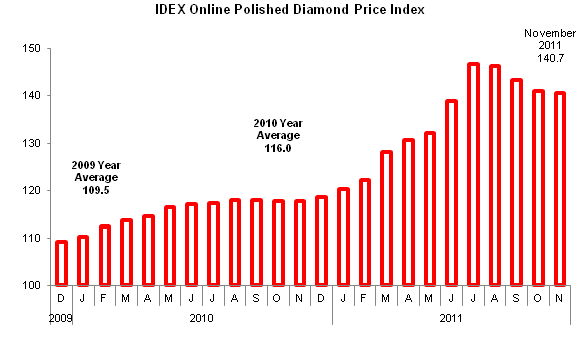 Source: IDEX Online |
Polished Diamond Prices Slackened Throughout November
The highest polished diamond prices occurred at the first of the month, with the IDEX Online Index at 142.7 on the first day of the month. From then onward, polished diamond prices slipped slowly to 139.3 at the end of the month.
Since then, in the opening days of December, polished diamond prices have continued to show weakness, with the IDEX Online Index at just above 139.
The graph below illustrates the daily average price of polished diamonds during November 2011.
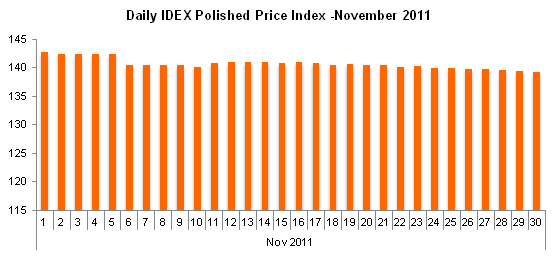 Source: IDEX Online |
Month-to-Month Polished Diamond Prices Soft
When polished diamond prices are compared between November 2011 and October 2011 – based on the average price for the month – prices slipped by 0.2 percent in November. This decline, which represents a moderating in the decline from prior months, was the fourth monthly drop since prices peaked in July 2011. Four months ago – in July – the month-to-month increase in diamond prices was 5.6 percent: this out-sized gain should have been a sign that we were nearing the top of a price bubble.
The graph below illustrates month-to-month price trends for polished diamonds. While there was some softness in mid-2010, prices had been quite strong until August.
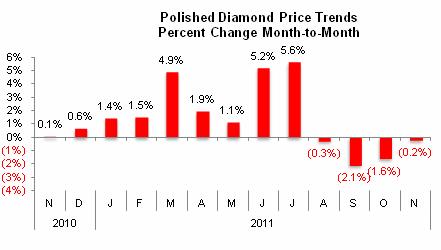 Source: IDEX Online |
On an annualized basis, the November month-to-month price decrease would be about 2 percent to 3 percent or so. This annualized price decline is dramatically more modest than last month’s annualized decline of 19 percent, but it still represents a major shift from historic polished diamond price trends.
Year-to-Year Polished Diamond Prices: Rate of Inflation Slows
Polished diamond prices in November rose by 19.3 percent from the same month a year ago, based on average prices during the month. This gain was eclipsed by the 25.0 percent rise in July, a 24.1 percent gain in August, a 21.4 percent gain in September, and a 19.7 percent gain in October.
It reflects some of the air being let out of the price bubble that has built up in the post-recession recovery period. Year-to-year comparisons are important because they take the seasonality out of diamond demand trends. In addition, they provide a longer-term view of trends, which are almost always less volatile than month-to-month comparisons.
The graph below shows that November’s polished diamond price increase of 19.3 percent is well above some prior gains over the past year, but below the record increase for July. Further, it reflects a slowing year-to-year price comparison.
IDEX Online Research had never seen diamond prices rise so sharply earlier this year, when reviewing polished price history over the past few years. In the heady days of early and mid-2008, just before the Great Recession gripped the jewelry and diamond industry with its “take no prisoners” bone-crushing decline, year-over-year prices were rising in the low-to-mid teen range.
By mid-2009, polished diamond prices were declining by mid-teen levels, but turned positive at the beginning of 2010, and perked up significantly by mid-year 2010. Since then, there has been no slowdown in polished diamond price increases, until mid-year 2011.
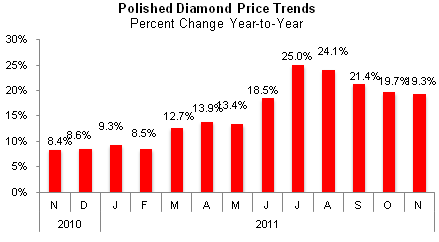 Source: IDEX Online |
Prices Diamond Prices Mixed By Size
Month-to-month prices were mixed in November 2011 for key sizes of diamonds. Gemstones of one-half carat, one-carat and three-carat showed the greatest month-to-month price decline, while five-carat diamonds posted a solid price increase over the prior month.
The graph below shows polished diamond price trends on a month-to-month basis – November 2011 versus October 2011 – for key diamond sizes.
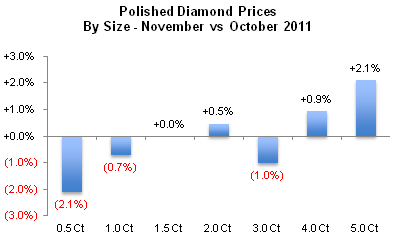 Source: IDEX Online |
On a year-to-year comparison, polished diamond prices in November 2011 were up for the key diamond sizes. Diamonds one-carat and smaller posted sizable price gains, while prices of four-carat diamonds also rose sharply. Price gains were more modest for 1.5, 3.0 and 5.0-carat gemstones. This pricing disparity is more or less similar to price trends over the past few months.
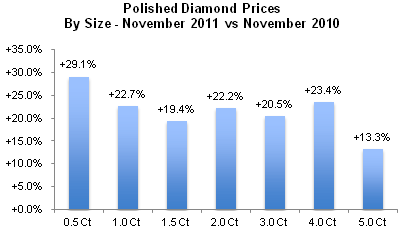 Source: IDEX Online |
The graph below summarizes three years of prices for key polished diamond gemstone sizes and qualities. After rising slowly since mid-2010, polished diamond prices have shown a downward bias for the past three months.
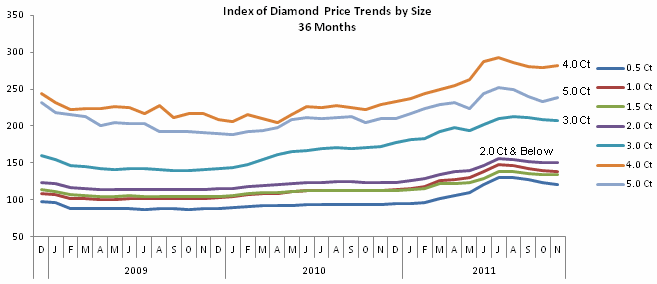 Source: IDEX Online |
Outlook: Polished Prices Poised for a Pause?
Historically, polished diamond prices have risen by 3-4 percent annually. However, due to decreasing supply coupled with increasing demand from new markets, it appears that diamond prices – over the long term – will likely continue to rise above their historic trends.
We note, with caution that these seemingly “new” trends often turn out to be unsustainable. While the long-term price and demand outlook for diamonds remains positive, diamantaires must remember that diamonds are a discretionary consumer purchase. At some point, shoppers may find a less-expensive alternative, and diamond demand could wane.